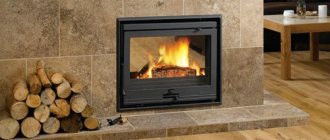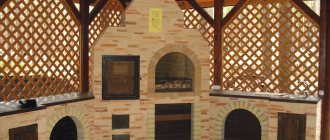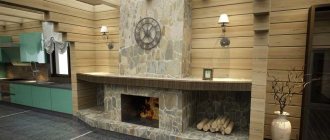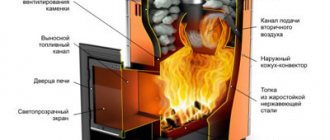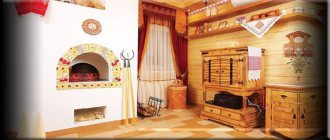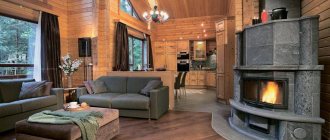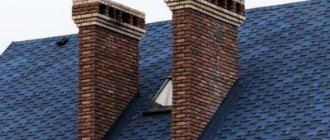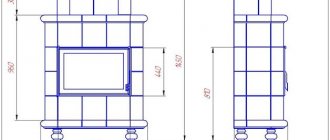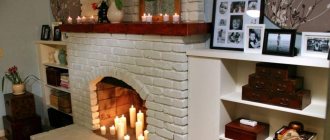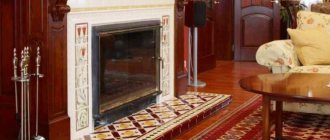Decorating a fireplace using stucco
Portals for stucco fireplaces can increasingly be found indoors. Many people decorate their homes with them, and this is not uncommon today. It's not so difficult to make a false fireplace from stucco ,
You can find many articles on this topic on our website. There is also a photo from which you can choose the desired design, and step-by-step instructions for completing the work. All this can be done with your own hands and without resorting to outside help. In this article we decided to tell you how to make a fireplace with stucco.
Construction method
For craftsmen with “straight” hands and a lot of free time, the idea of building a false fireplace from wood will be interesting.
There are no particular difficulties in constructing such a building, the main thing is patience and a pedantic approach. For people who do not have such an opportunity, but want to install a beautiful artificial fireplace in their home, in the decoration of which they would take a direct part, an excellent option would be to purchase a portal blank. It can be made of polyurethane or gypsum. All that remains is to install it in the right place and decorate it with your own hands at your own discretion.
Sculptural and profile gypsum portals for fireplaces are sold in construction stores. Choose a structure that suits the overall interior concept. In this case, your home will harmoniously fit into the design of the room and will definitely become a spectacular highlight of the whole house.
Sculptural portal with an electric fireplace inside
After you have purchased a portal for a false fireplace made of plaster, it should be securely attached to the wall and floor. The corresponding fasteners are included with the product.
After installation, you can proceed to decorating yourself. There are countless options here, what can you do:
- If you feel like your decorative plaster fireplace isn't embellished enough, you can always take advantage of the added value of plaster molding. By attaching additional moldings, friezes, and pilasters using special glue, you will get a structure of the required type. Stucco molding includes not only figures and patterns, but also other, very different decorative elements of the external facade of the fireplace.
- Painting the building in the desired color is not difficult. Water-based or acrylic paints should be used. In addition, plaster darkens or turns yellow over time, which means it is advisable to carry out such work. For classic options, white or antique colors are always appropriate. An interesting look for a fireplace is obtained by painting it like marble, as well as painting its individual elements with gold or silver paint.
Marble decorated plaster portal
- In the firebox of the portal, it will not be difficult to simulate a live fire using an LCD monitor or in another way. An excellent solution would be to place candles, decorative or real firewood, branches, and pine cones. In order for a false stucco fireplace to emit light, it is permissible to place an LED strip in the improvised firebox. A mirror wall will help enhance the glow. If you want to create a purely decorative structure, you can decorate the interior of the firebox with brickwork or ceramic tiles.
- Decorating the space around the false fireplace will help complete the picture. To do this, you can place in some proximity the accessories necessary for the operation of the classic analogue (pokers, ash scoops, etc.), and put firewood.
Fantasy will help you create an individual, exclusive design from standard elements.
Choice of stucco
Element of stucco decoration made of polystyrene foam
The choice of decorative stucco for the fireplace is made based on the type of fuel that is used for it. Regarding this, there are two types of hearth design:
- Natural fireplace.
- Electric fireplace.
If the finishing material option is incorrectly determined, soot, carbon deposits or other traces of equipment use will appear on the finish. The main task when using decorative fragments is to harmoniously complement the main structure with the interior where it is located.
Based on the production technologies of gypsum portals, there are three main types:
- Profile. When the portal is decorated with various details of finishing material: pilasters, friezes, moldings.
- Sculptural. When the main role is played by the central part of the portal, decorated with various figures, atlases, frescoes, bas-reliefs or caryatids.
Rules for choosing artificial stone
In all the variety of products offered from this artificial material, it is easy for an unprepared buyer to get confused. To prevent this from happening, it is necessary to identify the main positions by which this material should be selected.
Criterias of choice
Base materials. They can be very diverse - granite, marble, sand chips, gypsum. The choice will depend on preferences and the style in which the stove or fireplace is lined. Safety certificates. In the production of facing materials, many substances containing complex chemical compounds are used. Therefore, a hygienic certificate for the product is required. Type of substrate. Finishing the stove with flexible stone involves the presence of curved surfaces. Regular rectangular blocks are suitable for strict geometry with angles of 90 degrees. Date of production. Artificial elements must rest for at least a month before they can be worked with
You should pay attention to the production date of the batch on the packaging.
The best manufacturers
Is it possible to line a stove with artificial stone without buying expensive European materials? Below are comparative examples to help you navigate the prices and make your choice:
- Artificial elements of the “Byzantium” series. Russian production from New Technologies Stone. Price per 1 sq. meter - 1130 rubles.
- Artificial alpine slate. Available in several colors. Russian production. The cost is 540 rubles per 0.5 sq. m. meters.
- Gypsum cement tiles "Chateau". Produced by Russian. Environmentally friendly inorganic materials are used as dyes. The price is 290 rubles per 0.5 sq. meters.
- Artificial elements of the Milan series. Russian production from New Technologies Stone. Price per 1 sq. meter - 1064 rubles.
- Artificial cream facing stone REDSTONE Old Peter SP-13/R. Russian production, price per 1 sq. meter will be 1250 rubles.
- Facing elements White Hills Fjord Land, lilac color. Russian production, 45 pieces per package, price per 1 sq. meter will be 1160 rubles.
- Facing elements “Ideal Stone”, Booth collection. Produced by Russian. The cost is 990 rubles per 1 sq. meter.
- Artificial facing stone “Ideal Stone”, Jura marble collection. Produced by Russian. The cost is 1390 rubles per 1 sq. meter.
- White Hills North Ridge siding, white. Russian production, 15 pieces in a package, price per 1 sq. meter will be 1450 rubles.
- White Hills Rutland cladding elements, white. Russian production, 21 pieces in a package, price per 1 sq. meter will be 1320 rubles.
Use of gypsum decor and its use
Fireplaces with plaster stucco can be found quite often. The main advantages and advantages of the material include:
- Fireplaces made from stucco are not prone to shrinkage. Due to this, they perfectly maintain their original shapes and sizes over a long period of operation of the fireplace;
- It has good fire resistance. Which allows, from a fire safety point of view, to use it for decoration both in a house and in an apartment;
- Cladding the fireplace with plaster makes its surface durable. Gypsum is distinguished by its durability, strength and high quality;
- Eco-friendly. Belongs to the category of natural, environmentally friendly and natural coatings. Which makes it absolutely safe for health. When heated, it does not smolder and does not emit combustion and decay products dangerous to life and health into the air;
- Used for finishing portals with an electric fireplace. Since its electrical conductivity is zero.
Decorative plaster cast portal
Decorative plaster cast portal
Large and massive wall frame with stucco molding
Large and massive wall frame with stucco molding
Making gypsum stucco with your own hands
In order to make such a decor with your own hands, you need to use the following step-by-step guide:
Select the shape and size of the required element
It is equally important to think about its color design and place of attachment, so that each element is ideally suited and combined with the chosen location;
The solution for forming the part can be either purchased at a specialized hardware store and diluted according to the manufacturer’s instructions, or prepared at home yourself;
For 1 kilogram of dry powdered gypsum, take about 700-800 milliliters of water;
If a solution of medium consistency is required, for 1.5 kilograms of gypsum, take about 1 liter of water;
To apply and create shapes, it is recommended to use a special stencil. You can make it yourself;
Apply a layer of plaster to it and remove all excess;
After the solution has completely dried, we process and polish the surface.
Marking and removing excess gypsum mortar
Marking and removing excess gypsum mortar
Quite a complex and delicate pattern made by a professional
Quite a complex and delicate pattern made by a professional
Production of volumetric figures
If you want to make a fairly voluminous figure or an entire complex composition, we recommend using the following tips and instructions:
- Prepare a soap solution. For these purposes, it is recommended to use special liquid soap. This will make the process as easy as possible and at the same time avoid the formation of lumps and other compactions;
- Lubricate the special mold with the prepared solution;
- The gypsum solution must be poured into the mold in portions. Such consistency and unhurriedness is necessary so that the previous layer partially dries;
- After all layers have completely dried, you must carefully remove the product from the mold;
- We grind the surface of the element, adjust its shape if necessary and fix it on the surface of the fireplace portal using special gypsum glue.
Ready-made gypsum stucco molding for decorating the surface of the fireplace
Ready-made gypsum stucco molding for decorating the surface of the fireplace
Production of volumetric elements using a stencil
Production of volumetric elements using a stencil
Stucco for the fireplace: style, shapes and colors
Most often used in classical interior design and its varieties: Baroque, Rococo, Renaissance, Empire. Interior French stucco molding is appropriate in Art Nouveau and Provence styles.
Popular stucco ornaments:
- Geometric, combining chains of balls, rhombuses, squares and rectangles with straight, wavy and broken grooves.
- Classic, representing a complex pattern of graceful curls, rosettes, carving elements and openwork meshes.
- Floral in the form of intertwining branches, voluminous flowers, petals and leaves.
At the peak of popularity, stucco molding is classic white, but strict black and bright colors are increasingly used when decorating fireplace portals. The combination of different color solutions will allow you to create original visual effects, unique reliefs, and play of shadows.
Decorative coatings with the effect of gilding, patina, and stained wood are used as finishing. Imitation of marble, ivory, stone stucco, and artificial aging of the surface are in fashion.
The use of elegant stucco molding in a modern interior will create an indescribable comfort in the room, and moderation and the right combinations will make the fireplace its main decoration.
Ornate molding patterns frame the baroque gas fireplace panel.
The stucco elements are painted white with gold accents. The right fireplace for an Empire style interior.
The complex stucco pattern was created by real masters commissioned by a German politician.
What is a decorative fireplace and its purpose?
The installation of such decoration as a false hearth will allow you to decorate almost any room in an original way. A pseudo-fireplace decorates a room, but is not always equipped with a heating element.
Advantages and disadvantages of false fireplaces
A modern imitation of any fireplace has many advantages:
- the product is completely fireproof;
- various things are stored and stored in it;
- This is a most original decoration;
- pseudo-hearth creates comfort;
- made from almost any materials;
- It’s easy to do it yourself, without any special financial investments.
To make an artificial fireplace look relevant and stylish, you will have to think through many details: from its appearance to its location in the space of the room.
But there are also a number of disadvantages:
- the artificial fireplace does not heat;
- with large dimensions, the item takes up valuable space in the room;
- It will take time to create and decorate the hearth.
Style of stucco for the fireplace
- Finishing the fireplace “like a stone” gives the fireplace a massive and natural feel to the room’s decor.
- Classic stucco decoration of the hearth - used to give the design of the room an ambience of medieval style and the spirit of antiquity.
- The fireplace cladding is made in an antique style - artificially aged decorative fragments that fill the room with an atmosphere of home comfort that has warmed more than one generation. Such fireplaces with stucco in the photo are presented in a variety of variations, which allows them to be integrated into any room design.
Options for simulating a decorative fireplace with your own hands
Decorative fireplaces are divided into the following groups:
symbolic. Any material can be used to create them. The peculiarity of such a decorative fireplace in an apartment is its dissimilarity with the usual fireplace. An example is his image on the wall, decorated with decorative paraphernalia;
The fictitious fireplace resembles a real one, but there is no real flame in it
- conditional. Thanks to the self-created portal protruding from the wall, this type of fireplace is very reminiscent of a real one. At the same time, you can decorate it as you wish, for example, by placing firewood or candles in the firebox;
- reliable. This is an option for the most complete imitation of a fireplace in an apartment, in compliance with the principles of design and the appropriate dimensions of the structure. To create the effect of a real flame, the inside of the pseudo-firebox is equipped with a bioburner. The impressive price of this option is offset by its extreme realism.
You can make a decorative fireplace with your own hands from a variety of materials. Moreover, any such design is characterized by ease of implementation. The materials you will need can be purchased at any hardware or construction store, and a number of them can even be found at home.
Recommendations for installing stucco elements
Decorating the fireplace with stucco
Using these tips, you can diversify and harmoniously fit certain figures into the main structure, as well as complement and transform the style of the room.
- If the style of the room is made in a medieval direction, then the fireplace portal must be decorated with “stone stucco”. This will give massiveness and fundamentality to the main product.
- For an antique style interior, material in a classic style is suitable. It can also be used for a medieval style; the interior will only benefit in this case.
- To create home comfort, you can use a version of the material with elements of aging.
- And to give the fireplace a touch of individuality or exclusivity, you can use a combined design method, using elements from various materials.
What can be placed in a false fireplace
Inside the fake fireplace, real candles are placed in metal candlesticks, a bright salt lamp, and an LED strip around the perimeter of the portal. Inside the structure they place logs or their imitation made of cardboard, old chests and read books, shoe boxes and baskets made of pine roots, inside of which souvenirs or board games are stored. For beauty, they are painted to look like birch firewood with bark.
It is permissible to decorate the structure before each holiday. Bright garland lights and shiny foil snowflakes for the New Year, paper or cotton angels for Christmas, green leaves in the spring and yellow-red-brown ones for the beginning of autumn. On Halloween, the fireplace is decorated with small pumpkins, faces carved on them and lanterns inside. Paper flowers, forest driftwood, children's drawings, crafts made from acorns and pine cones are also quite acceptable.
The fireplace is installed in such a place that it does not interfere with the movement of residents.
The wall-mounted fireplace plays the role of the main accent in the interior; sofas and armchairs are placed around the viewing point.
How to make a decorative fireplace from a ready-made portal?
False fireplaces made of plaster are popular today. If you have no experience working with such material, but want to decorate the room with similar decor, we recommend choosing a simple hearth shape. In special stores you can choose beautiful sculptural elements that are perfect for interior decoration in a classic style.
Ready portal
The finished portal easily turns into a beautiful decor. The easiest option is to fix the portal to the wall surface, after which it is decorated in the general style. A portal made of gypsum does not have much weight, so it can be installed in any room without thinking about the strength of the floors.
The blanks are easily painted in various color shades, tinted with dyes that imitate natural wood and natural marble.
Inside the symbolic firebox, lighting is installed, or LED stoves are installed, which are considered safe in terms of fire. To obtain the maximum decorative effect, the inner parts of the walls are finished with materials that differ from those with which the outer walls of the structure are finished.
Construction
Step-by-step instructions will help you navigate the construction methodology:
Fastening the metal profile to the floor and wall
At the first stage, we need to make markings on the floor and wall, based on a drawing or sketch of the fireplace made on paper. To better see the markings, use a marker, and for accuracy, use a ruler and level
It is very important not to make serious mistakes when marking. If you plan to install an electric device inside the corner portal of your false fireplace, then you need to supply electricity to the corner. The easiest way is to make an outlet behind the fireplace, where an electric fireplace or other built-in device will be connected.
The fireplace takes on a general shape
The markings are ready, we will carry out further work with our own hands. We take a metal profile and build the necessary structure from it. We use the floor and walls as the basis for fastening. If necessary, make rounded elements, cut the profile and bend it.
Drywall-clad fireplace frame
When the frame is built, we begin to work with drywall. We need to cut the large sheet into small pieces according to the dimensions on the drawing, and then attach these pieces of drywall to the metal frame. As we have already said, when making a corner fireplace from plasterboard with your own hands, you need to carefully monitor the dimensions so as not to waste material. Note that the self-tapping screws should be screwed in completely and even sunk a little into soft drywall so that their heads are not visible later.
Finishing the fireplace with suitable decorative materials
When the drywall is fixed, you need to take putty and modify the image of the fireplace and its shape. You should cover the recesses of the screws, make even corners and joints. When the putty dries, you can use a knife and sandpaper to make the surface more ideal. Finally, it is necessary to treat the drywall and putty with a primer to make it easier to attach the finishing materials, or to paint the resulting false fireplace.
The exterior of the fireplace is finished
Having built the base of the structure, you can proceed directly to its external and internal decoration. It's better to start with the firebox. If you plan to install any device inside, you should do the appropriate finishing. For example, if a bio-fireplace burner or real candles are installed, then the base should be strengthened by laying tiles down, and the inside of the firebox should be finished with heat-resistant material, asbestos, or steel. If the firebox is empty, finishing can be done at will from any materials.
- After the firebox, we move on to the main external part. To decorate a corner fireplace, you can use ceramic tiles, stone or its imitation, plastic panels, siding, there are many options. The decorative material is glued to the frame using glue. This glue usually dries in about a day.
- A tabletop should be installed on the top of the frame; you can choose a wooden or stone option, depending on your preferences. You can later place decorative items and souvenirs on this tabletop.
Filling the fireplace insert with decorative elements
Note that in addition to expensive finishing materials, there are also quite budget options. For example, a fireplace in the corner of a room can simply be painted with paint of a suitable color; the simplest option is white. Drywall, even primed, absorbs moisture well, so it will have to be painted in two layers.
You can cover the frame with self-adhesive film with a suitable pattern or color. Film is not the most practical option, besides, we recommend choosing a German manufacturer, since the Chinese one has too many problems with quality (it constantly peels off at the joints and in the corners).
Exterior view of a corner false fireplace in the living room
Upon completion of construction, the necessary parting should be installed in the firebox: a bio-fireplace or an electric fireplace. An interesting option is to place a photo frame inside the firebox, on which there will be an image of a real fire.
Candles in the firebox are always appropriate; they can be real or artificial, for example, in the form of a kind of garland that gives a pleasant flicker. Decorative firewood fits perfectly into this concept, which you can also make yourself or buy ready-made options.
You can build a corner false fireplace with your own hands not only from plasterboard; simple options are very popular, when the structure is made from ordinary cardboard boxes.
Independent design of a gypsum portal
DIY plaster elements
Let's try to figure out how to make a fireplace from plaster with your own hands.
To make the fireplace look beautiful, it is recommended to approach the design work with full responsibility, because the beauty of the entire structure will depend on this.
You can copy your favorite sculptures using plaster elements, and then the entire structure will look unusual and delightful. To create harmony in the interior, it is recommended to copy certain patterns from furniture or fabrics. This is done quite simply, because gypsum is a plastic and easy-to-work material.
If you have creative skills, you can easily mold various shapes or patterns from plaster. Note that beginners should not be upset, because the store sells any decorative elements made of plaster. In addition, you can always order exclusive jewelry from the workshop.
Preparation of the solution
Anyone who wants to try their hand at working with gypsum material is recommended to learn how to mix a suitable mortar mixture. Based on what kind of stucco molding you need to decorate your fireplace, prepare mixtures of different consistencies:
- for a thick mass you will need one kilogram of gypsum and 500 ml of water;
- average density is achieved by increasing the volume of water to 600 - 700 ml per 1 kg of material;
- The liquid state is obtained by mixing a share of gypsum in 800 - 900 ml of water.
If you need to create a large figure, then there is no need to mix a large amount of mortar - its construction is carried out in separate parts. For thin elements, a liquid solution is used, which easily fills recesses and voids.
Selection of decorative elements
Now let's look at how high-quality modeling is performed.
Before applying the gypsum solution to the portal, it is necessary to draw the contours of future patterns on its surface. To make the process easy, it is recommended to use stencils to achieve clear symmetry.
Molding stucco molding from plaster
Now you can prepare a solution of the required consistency and apply it evenly to the portal, rubbing it on all sides.
Patterns, depressions and elevations are formed according to the applied drawings, the remaining mixture is removed. After the plaster has completely dried, the patterns are sanded using sandpaper.
If you want to strengthen decorative elements of complex shapes on the portal, they will have to be made separately. This plaster molding will become a source of pride for you.
Subtleties of decoration
When making elements for decoration, it is recommended to use the advice of experienced craftsmen:
To create the necessary element, a mold is first prepared into which the gypsum mixture will be poured. Complex structures are made of plasticine, onto the surface of which the first layer of gypsum solution is applied with a brush; immediately before work, the molds are treated with a solution of ordinary soap so that the process of removing the finished element does not cause difficulties; The gypsum solution is poured in several stages, each of which involves a layer no more than one centimeter thick. The next fill is performed after the previous one has completely dried.
During operation, it is necessary to ensure that no air bubbles remain, which can be removed by simply shaking the molds; The frozen products are carefully removed from the molds and polished. In order for the drying process to take place efficiently, the molds with shaped products are placed in an oven, which creates a temperature regime of one hundred and sixty degrees Celsius.
A fan, battery and hair dryer are not used, because during drying they can cause deformation of the products; at the final stage, the hand-made stucco molding is glued to the surface using a special adhesive composition.
Creating stucco is a very exciting and interesting process, but quite complex. During the working stages, difficulties will certainly arise in mixing the mortar mixture of the required consistency; symmetry in the patterns will be quite difficult. But each resulting ornament will be 100% individual and will be an excellent option for interior decoration.

